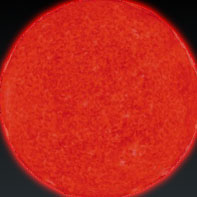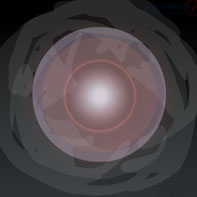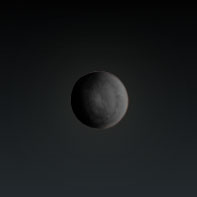Death of Low Mass Stars
The fate of a star depends on its mass. Low mass stars like the sun in their dying stages shed their outer layers transferring most of their mass into the interstellar medium. Massive stars go out with a bang as supernovas ejecting heavy elements into the interstellar medium.
- Low mass stars end up as white dwarf stars and eventually black dwarf stars.
- High mass stars end up as neutron stars and in some cases black holes.
Low mass stars – White dwarf Stars
The animation below shows the final stages of a yellow dwarf star into its formation of a white dwarf.
Yellow Dwarf |
 Yellow dwarfs are the remains of stars with a mass less than three solar masses i.e. a mass less than three times the mass of our sun Yellow dwarfs are the remains of stars with a mass less than three solar masses i.e. a mass less than three times the mass of our sun
|
Red Giant |
 Towards the end of the main sequence stage all the hydrogen in the core of the star is exhausted and transformed to inert helium. Without the hydrogen the thermonuclear reactions in the core stop and gravity compresses the core to a smaller size. Surrounding the core is a layer of hydrogen; gravitational contraction provides enough energy for nuclear fusion of the hydrogen in this layer. The outward pressure from the nuclear reaction prevents the star from collapsing and makes it expand to several hundred times its former size. Due to the expansion of the outer layers the energy from the hydrogen layer is spread over a larger surface area resulting in a lower surface temperature and a shift in the stars light output to a red wavelength. The star has now become a red giant. Towards the end of the main sequence stage all the hydrogen in the core of the star is exhausted and transformed to inert helium. Without the hydrogen the thermonuclear reactions in the core stop and gravity compresses the core to a smaller size. Surrounding the core is a layer of hydrogen; gravitational contraction provides enough energy for nuclear fusion of the hydrogen in this layer. The outward pressure from the nuclear reaction prevents the star from collapsing and makes it expand to several hundred times its former size. Due to the expansion of the outer layers the energy from the hydrogen layer is spread over a larger surface area resulting in a lower surface temperature and a shift in the stars light output to a red wavelength. The star has now become a red giant.
|
Helium Flash |
 In low mass stars helium burning begins suddenly in a process called the Helium Flash. This process initiates the steady conversion of helium into carbon in the core accompanied with hydrogen burning in the outer shell. This stage can last for less than 1000 million years leaving carbon as the leftover ash. In low mass stars there is insufficient mass to increase the core temperature by gravitational contraction to trigger fusion of the carbon, so thermonuclear reactions stop. Helium burning continues for a while in a shell around the core and eventually stops. The outer shell is ejected into space and this cooler thinner matter is called a planetary nebula. In low mass stars helium burning begins suddenly in a process called the Helium Flash. This process initiates the steady conversion of helium into carbon in the core accompanied with hydrogen burning in the outer shell. This stage can last for less than 1000 million years leaving carbon as the leftover ash. In low mass stars there is insufficient mass to increase the core temperature by gravitational contraction to trigger fusion of the carbon, so thermonuclear reactions stop. Helium burning continues for a while in a shell around the core and eventually stops. The outer shell is ejected into space and this cooler thinner matter is called a planetary nebula.
|
White Dwarf |
 With no thermonuclear reactions there is no longer any outward pressure to halt the gravitational contraction. The core is compressed to roughly the size of the Earth. The density of the matter increases to approximately 108 – 109 kg/m3. A teaspoon of white dwarf matter would have a mass of several tonnes. As the star cools further the material takes on a crystalline lattice structure being made up of ionised atoms with freely moving electrons. The star moves from a gaseous state through to a liquid and then becomes a solid. With no thermonuclear reactions there is no longer any outward pressure to halt the gravitational contraction. The core is compressed to roughly the size of the Earth. The density of the matter increases to approximately 108 – 109 kg/m3. A teaspoon of white dwarf matter would have a mass of several tonnes. As the star cools further the material takes on a crystalline lattice structure being made up of ionised atoms with freely moving electrons. The star moves from a gaseous state through to a liquid and then becomes a solid.
|
Black Dwarf |
 As thousands of millions of years go by, the white dwarf becomes cooler and dimmer until its surface temperature approaches absolute zero and its life ends. The remaining burnt out cinder is referred to as a black dwarf. As thousands of millions of years go by, the white dwarf becomes cooler and dimmer until its surface temperature approaches absolute zero and its life ends. The remaining burnt out cinder is referred to as a black dwarf.
|

 Yellow dwarfs are the remains of stars with a mass less than three solar masses i.e. a mass less than three times the mass of our sun
Yellow dwarfs are the remains of stars with a mass less than three solar masses i.e. a mass less than three times the mass of our sun Towards the end of the main sequence stage all the hydrogen in the core of the star is exhausted and transformed to inert helium. Without the hydrogen the thermonuclear reactions in the core stop and gravity compresses the core to a smaller size. Surrounding the core is a layer of hydrogen; gravitational contraction provides enough energy for nuclear fusion of the hydrogen in this layer. The outward pressure from the nuclear reaction prevents the star from collapsing and makes it expand to several hundred times its former size. Due to the expansion of the outer layers the energy from the hydrogen layer is spread over a larger surface area resulting in a lower surface temperature and a shift in the stars light output to a red wavelength. The star has now become a red giant.
Towards the end of the main sequence stage all the hydrogen in the core of the star is exhausted and transformed to inert helium. Without the hydrogen the thermonuclear reactions in the core stop and gravity compresses the core to a smaller size. Surrounding the core is a layer of hydrogen; gravitational contraction provides enough energy for nuclear fusion of the hydrogen in this layer. The outward pressure from the nuclear reaction prevents the star from collapsing and makes it expand to several hundred times its former size. Due to the expansion of the outer layers the energy from the hydrogen layer is spread over a larger surface area resulting in a lower surface temperature and a shift in the stars light output to a red wavelength. The star has now become a red giant. In low mass stars helium burning begins suddenly in a process called the Helium Flash. This process initiates the steady conversion of helium into carbon in the core accompanied with hydrogen burning in the outer shell. This stage can last for less than 1000 million years leaving carbon as the leftover ash. In low mass stars there is insufficient mass to increase the core temperature by gravitational contraction to trigger fusion of the carbon, so thermonuclear reactions stop. Helium burning continues for a while in a shell around the core and eventually stops. The outer shell is ejected into space and this cooler thinner matter is called a planetary nebula.
In low mass stars helium burning begins suddenly in a process called the Helium Flash. This process initiates the steady conversion of helium into carbon in the core accompanied with hydrogen burning in the outer shell. This stage can last for less than 1000 million years leaving carbon as the leftover ash. In low mass stars there is insufficient mass to increase the core temperature by gravitational contraction to trigger fusion of the carbon, so thermonuclear reactions stop. Helium burning continues for a while in a shell around the core and eventually stops. The outer shell is ejected into space and this cooler thinner matter is called a planetary nebula. With no thermonuclear reactions there is no longer any outward pressure to halt the gravitational contraction. The core is compressed to roughly the size of the Earth. The density of the matter increases to approximately 108 – 109 kg/m3. A teaspoon of white dwarf matter would have a mass of several tonnes. As the star cools further the material takes on a crystalline lattice structure being made up of ionised atoms with freely moving electrons. The star moves from a gaseous state through to a liquid and then becomes a solid.
With no thermonuclear reactions there is no longer any outward pressure to halt the gravitational contraction. The core is compressed to roughly the size of the Earth. The density of the matter increases to approximately 108 – 109 kg/m3. A teaspoon of white dwarf matter would have a mass of several tonnes. As the star cools further the material takes on a crystalline lattice structure being made up of ionised atoms with freely moving electrons. The star moves from a gaseous state through to a liquid and then becomes a solid. As thousands of millions of years go by, the white dwarf becomes cooler and dimmer until its surface temperature approaches absolute zero and its life ends. The remaining burnt out cinder is referred to as a black dwarf.
As thousands of millions of years go by, the white dwarf becomes cooler and dimmer until its surface temperature approaches absolute zero and its life ends. The remaining burnt out cinder is referred to as a black dwarf.